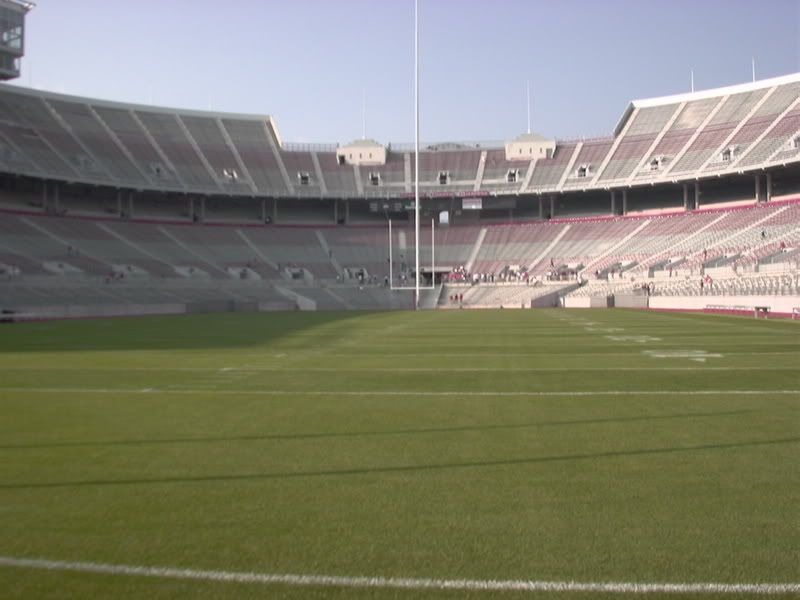 Buckeye Archive
Buckeye Archive  Turfgate
Turfgate

In case you haven't noticed ... the turf at Ohio Stadium looks like my redneck neighbors front lawn - minus the car on blocks, pinwheels, and pink flamingos.
There are huge dead areas and divots everywhere. Heck, it looks like most of the Columbus Municipal Golf Courses.
If you watch the game closely, you can see the players take up huge divots with their spikes, as though they were nine irons. Larry Grant’s slip on his interception return against Northern Illinois was a perfect example. Look at the tape if you can, his shoe tears a beaver pelt that would make Tiger Woods proud. The ground is giving that easily; it's really astonishing.
I have the opportunity to see the field every Sunday morning, and I took the opportunity to take a very close look at the grass to see what the hell the problem was. Don’t get me wrong, I am not a grass engineer (like that annoying neighbor with the perfect green carpet in front of his house), but I know a thing or two about a thing or two.
In order to assist the grass in its recovery following a game, it is common practice to aerate the grass and use the opportunity to inject sand into the roots. This helps with drainage and airflow and will generally hasten the recovery of the grass. Unfortunately ... there is an obvious side effect. If you do this a lot, you will have a lot of sand in your topsoil. If there is too much sand in your topsoil than the soil itself is weakened and you will pull huge divots out easily. Does this sound familiar?
As I looked down at the soil in my hand it became apparent to me that this is exactly what the problem is. If we mowed the grass short enough my kids could build a sand castle right there on the field. The “soil” looked to be about 50% sand.
This sounds really stupid, what is the big deal? The big deal is that this is a fast team and loose turf means that cutting and power are going to affect the faster team more. It has become such a big issue that the Athletic Department is footing the bill for new turf for the entire stadium at a cost of about $100,000. The replacement started on Sunday, following the Penn State game, and was completed this week.
The problem really does not end there though. Since the completion of the renovation project about six years ago, the Athletic Department has struggled to maintain the field between games as an unforeseen consequence of the renovation. During the renovation of the stadium, the field was lowered fifteen feet and the height of the stadium was increased by about forty feet. Now, especially following the Autumnal Equinox, the grass does not get the light necessary to grow and recover at a healthy rate, due to the height of the stadium and its “North-South” orientation.
The result of this quandary is that Ohio State will either be forced to replace the field every year or two, as the sand builds up in the top soil, or the university will be forced to install “Field Turf.” Right now, it appears as though the “Field Turf” side appears to be winning.
So enjoy the natural grass in Ohio Stadium while you can. This may be the last year for it.
- NBA Announces 2013-2014 Schedule
- Browns Ink Sharknado
- Sharknado A No-Show For Rookie Camp
- Trent Richardson Out Until Training Camp
- Browns Sign Brandon Jackson
- Carrasco Suspended Eight Games
- Browns Add to Wide Receiver Depth with David Nelson
- Browns Need to Learn from Past Draft Mistakes
- Browns Release Chris Gocong and Usama Young
- Browns Missing on Grimes Disappointing, But Not The End
The TCF Forums
- Official- Browns Coach Search/Rumors
HoodooMan (Tuesday, January 21 2014 1:36 PM) - Movies coming out
rebelwithoutaclue (Tuesday, January 21 2014 12:56 PM) - 2015 Recruiting
jclvd_23 (Tuesday, January 21 2014 12:38 PM) - The 2014 Offseason Thread
Larvell Blanks (Tuesday, January 21 2014 12:25 PM) - Chris Grant's first 3 drafts
Kingpin74 (Tuesday, January 21 2014 10:13 AM) - Mike Brown
YahooFanChicago (Monday, January 20 2014 11:15 PM) - 2014 Hoops Hockey Hijinx
jpd1224 (Monday, January 20 2014 4:44 PM) - 2014 Recruiting
jclvd_23 (Monday, January 20 2014 2:26 PM) - Wish List - #4 Pick
Hikohadon (Monday, January 20 2014 1:26 PM) - #1 overall pick Anthony Bennett
TouchEmAllTime (Sunday, January 19 2014 1:28 PM)


